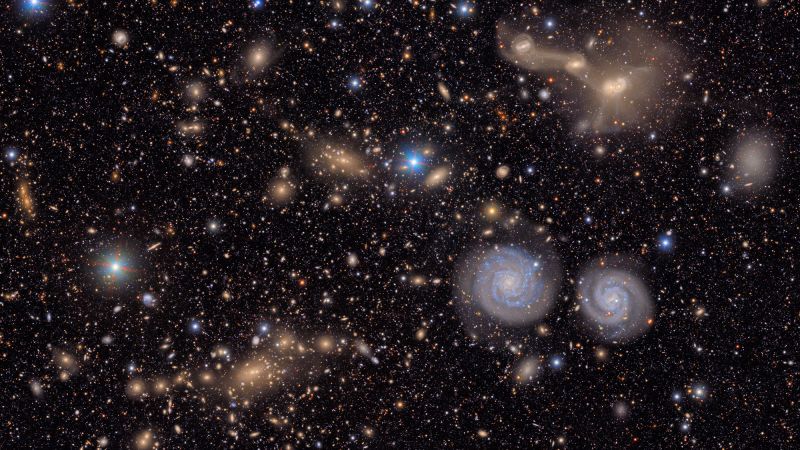The Vera C. Rubin Observatory has recently completed its initial test images, which have already begun to show the potential for significant astronomical discoveries. Named after the renowned astronomer Vera Rubin, who played a critical role in the study of dark matter, the observatory’s pioneering capabilities allow for unprecedented observations of distant stars and galaxies. The data it has captured is not only vast but also indicative of future findings; scientists expect it will uncover thousands of previously hidden asteroids within our solar system.
So far, the National Science Foundation has released a limited number of images and a brief clip demonstrating the observatory’s capabilities. These are just a glimpse of what the Vera C. Rubin Observatory can achieve. More comprehensive imagery, utilized from the largest astronomical camera ever constructed, is anticipated to be released on the agency’s YouTube channel. It is worth mentioning that this groundbreaking facility benefits from joint funding provided by the National Science Foundation and the Department of Energy’s Office of Science.
The new imagery, acquired over a mere 10 hours of testing, only marks the beginning of the observatory’s mission, which will span ten years. During this time, the facility aims to unravel cosmic mysteries as never before. National Science Foundation officials, including Brian Stone, who has stepped in as Chief of Staff, have expressed that the Rubin Observatory will contribute more data about our universe than all optical telescopes combined throughout history.
One of the first milestones of the observatory was the identification of 2,104 asteroids, including seven near-Earth objects that had not previously been detected. Thankfully, the newly identified asteroids do not pose any threat to our planet. This search for near-Earth objects is crucial, as Rubin is projected to discover millions of asteroids within its initial two years of operation—far surpassing the 20,000 typically spotted by ground and space telescopes annually. The highlight lies in its capacity to identify any interstellar comets or asteroids that may venture through our solar system.
A significant aspect of Rubin’s technological advancements lies in its mirror design and high-sensitivity camera. This allows the observatory to locate even the faintest celestial objects, including asteroids that might endanger Earth. By capturing thousands of images nightly, the observatory will track changes in brightness, adding an extra layer of detail to our understanding of space.
One sneak preview offered a mesmerizing video montage composed of over 1,100 images taken by the observatory. It begins with a close-up of two galaxies before zooming out to reveal about 10 million galaxies—all from just a fraction (0.05%) of the total 20 billion galaxies that Rubin aims to observe over a decade. Furthermore, the observatory’s team also presented a mosaic showcasing the Trifid and Lagoon nebulae, highlighting areas of star formation that are thousands of light-years from Earth.
Dr. Yusra AlSayyad, deputy associate director of data management at the Rubin Observatory, explains that the selected images aim to demonstrate the telescope’s extensive field of vision, allowing for intricate views of interacting galaxies alongside broader vistas of countless others. Meanwhile, Dr. Sandrine Thomas, the telescope project scientist, noted the exceptional speed and scope of observations, likening the experience to watching a movie of the cosmos.
Situated in the Andes mountains atop Cerro Pachón in Chile, the Vera C. Rubin Observatory is nearing completion after nearly two decades of labor. Its first light is anticipated to occur on July 4, marking the observatory’s first scientific observations of the Southern Hemisphere’s sky. The infrastructure, designed to accommodate its extensive observational capabilities, resides in a region known for its dry air and dark skies, ideal conditions for astronomical research.
The observatory’s primary goal is to conduct the Legacy Survey of Space and Time, a project that promises to capture an ultra-wide and ultra-high-definition timeline of the universe. The plan is to scan the entire sky every few nights over ten years, facilitating a dynamic compilation of events such as moving asteroids, exploding stars, and the evolution of galaxies.
Dr. Aaron Roodman, a prominent figure in the Rubin Observatory’s development and testing of the camera, emphasized the unprecedented opportunities the observatory will provide to study celestial phenomena. Its capabilities to identify and monitor vast amounts of dynamic objects will serve as a powerful tool for researchers and scientists.
Continuing Vera Rubin’s profound legacy, the observatory is anticipated to delve into many cosmic enigmas, particularly concerning dark matter and dark energy, which are critical components of our universe that remain elusive and barely understood. As Roodman expressed, the observatory’s unique ability allows for a fresh exploration of these foundational elements of cosmology.
In summary, the Vera C. Rubin Observatory is set to revolutionize our understanding of space through its extensive observational capabilities and innovative technologies. The achievements thus far, coupled with the promise of groundbreaking discoveries to come, mark a significant milestone in astronomy and our quest for knowledge about the universe.



